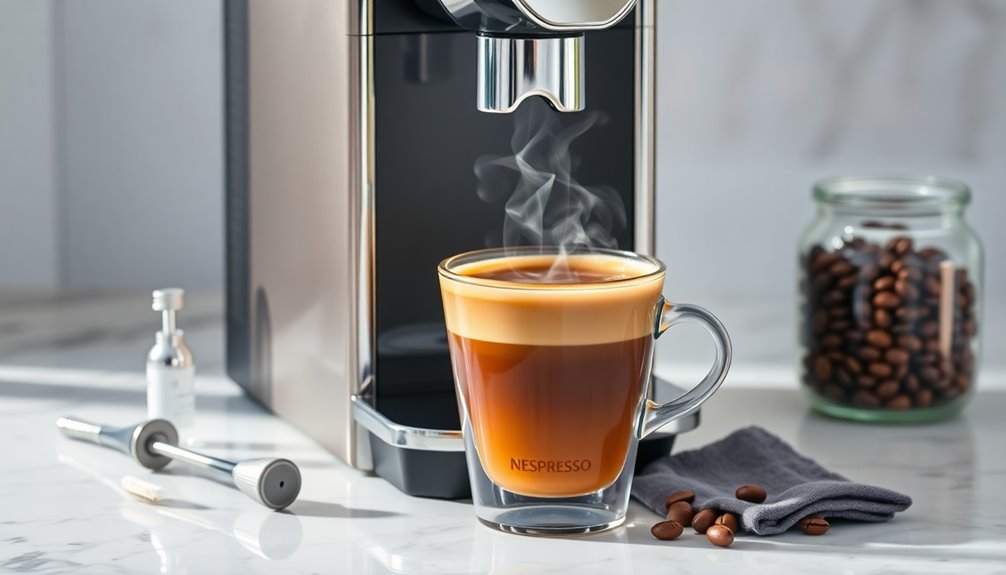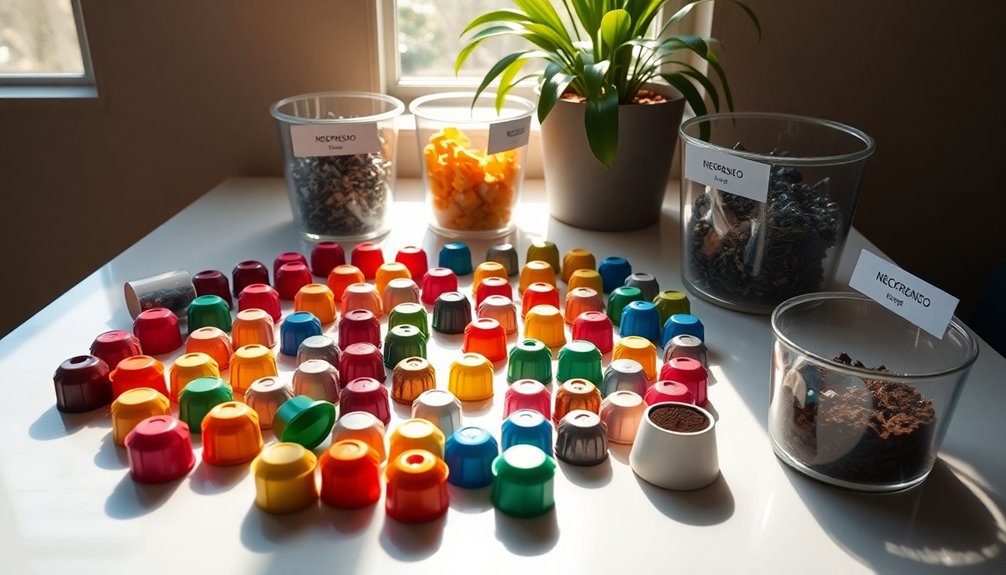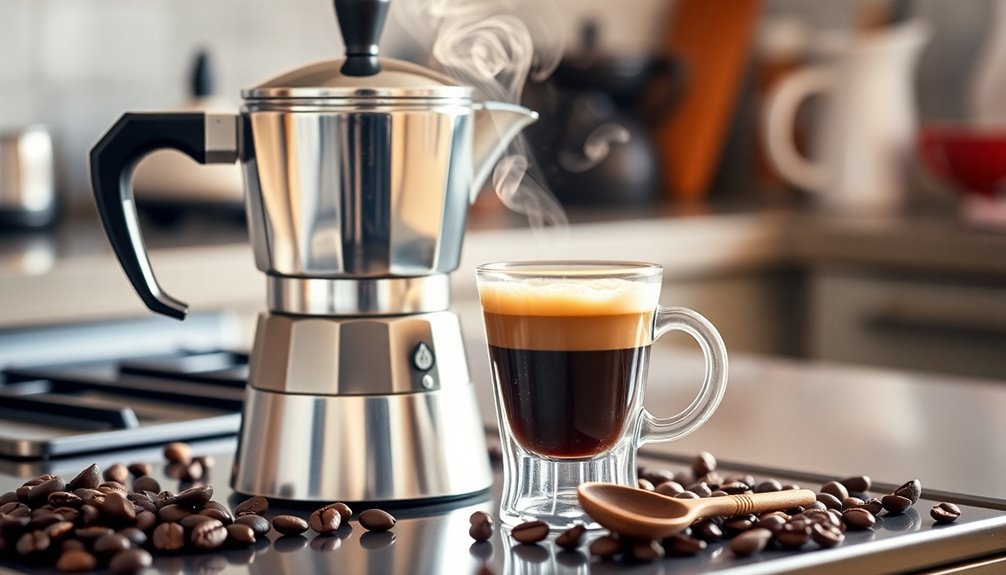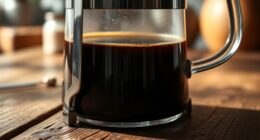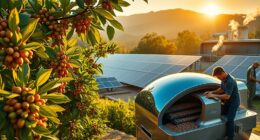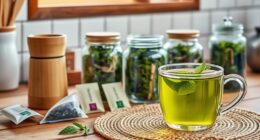If you're looking for the best siphon coffee makers, you'll find diverse options to suit your brewing style. Electric siphons offer ease and larger capacities, while stovetop models provide versatility with your stove. Siphons deliver unique brewing experiences, combining immersion and vacuum techniques for rich flavors and lower acidity. To get the most out of your brews, remember the essential coffee-water ratio and the importance of proper maintenance. Each model has its perks, and understanding them can enhance your coffee journey. Keep exploring to uncover the key features that'll help you choose the perfect siphon for your taste.
Key Takeaways
- Electric siphons are ideal for larger groups, offering automated features for convenience and efficiency in brewing multiple cups.
- Tabletop siphons provide a hands-on experience, allowing users to control the brewing process with external heat sources.
- Stovetop siphons are versatile, utilizing existing kitchen stoves for heating without the need for additional burners.
- Specialty siphons are decorative, offering a unique, nostalgic brewing experience that adds flair to coffee preparation.
- Proper maintenance, including rinsing components and inspecting seals, ensures longevity and optimal performance of siphon coffee makers.
Types of Siphon Coffee Makers

When you immerse yourself in the world of siphon coffee makers, you’ll find several types tailored to different brewing preferences and needs. Some siphon coffee makers are designed for quick and easy brewing, while others cater to the meticulous and patient coffee enthusiast. No matter the type, learning how to brew perfect coffee with a siphon maker involves mastering the art of temperature control, water-to-coffee ratio, and timing. With its unique brewing process, siphon coffee makers produce a clean, smooth, and flavorful cup of coffee that many coffee lovers swear by.
Electric siphon coffee makers, like the KitchenAid model, offer convenience with automated features and larger capacities, perfect for brewing multiple cups.
On the other hand, tabletop siphons require an external heat source, giving you greater control over the brewing process but demanding more manual effort. This manual effort is particularly rewarding as it allows you to fully appreciate the unique visual brewing experience of the siphon method.
Stovetop siphon coffee makers are versatile, using your stove's heat without needing an additional burner.
Finally, specialty and historical siphons, such as the Nispira Belgian Balance Siphon, not only brew coffee but also serve as decorative pieces, adding a touch of nostalgia to your kitchen.
Each type brings a unique experience to your coffee ritual.
Key Components of Siphon Brewers

Siphon coffee brewers rely on several key components that work together to create a unique brewing experience.
The bottom container, or bottom chamber, holds the water and serves as the final vessel for your brewed coffee. It connects to the top container via a tube and is heated by a burner.
The top container, also known as the brewing chamber, is where you place the coffee grounds and mix them with hot water. It features an open-ended siphon tube and requires a filter to separate the grounds from the liquid.
Additionally, the sealing material, typically rubber, guarantees a vacuum forms during brewing and balances pressure, while the filter, made from various materials, allows for proper extraction and filtration of your coffee. This method of brewing creates a pressurized environment that enhances the coffee extraction process, resulting in a flavorful cup.
How Siphon Coffee Makers Operate

Understanding how siphon coffee makers operate can elevate your brewing experience and enhance the flavor of your coffee.
First, you fill the lower chamber with water and heat it until it vaporizes into steam, creating pressure that forces the water up the siphon tube into the upper chamber.
Once the water's in the upper chamber, you add coffee grounds and stir to guarantee saturation. The recommended brewing ratio is 7 grams of coffee per 100ml of water for optimal flavor.
After about two minutes of brewing, you remove the heat source. As the lower chamber cools, the pressure drops, forming a vacuum that pulls the brewed coffee back down, filtering it through a cloth or paper filter.
This process results in a clean and flavorful cup, ready to enjoy.
Advantages of Siphon Brewing

While many brewing methods have their merits, siphon brewing stands out for several compelling reasons.
First, it guarantees consistent extraction and flavor profile by evenly distributing heat, resulting in a balanced cup with lower acidity. You'll appreciate the clean and delicate flavor, as the method filters coffee using cloth or metal, allowing natural oils to shine through. This creates a richer, more nuanced taste with preserved aromatics. Additionally, the unique vacuum system utilized in siphon brewing extracts all coffee elements, resulting in a full-bodied coffee experience that is truly exceptional.
Plus, siphon brewing is convenient and easy to use; once you master the setup, you can multitask while brewing in just a few minutes.
Finally, it offers a unique experience, combining immersion and vacuum techniques, giving you a visually enchanting show and a bright, syrupy cup that's hard to beat.
Selecting the Right Model

When you're ready to choose the right siphon coffee maker, consider factors like construction, heat source, and capacity to guarantee it meets your brewing needs.
Look for models made from engineered glass, like the Hario Technica, which offer durability and heat resistance. If you prefer easier heating, options with integrated burners, such as the Nispira Balance Syphon, provide precise control. The Hario Electric Coffee Siphon is a new design that enhances the brewing experience with its compact siphon design.
Think about the size too—if you often brew for a crowd, larger models like the Yama Glass 8-Cup are ideal. Compact designs work well for travel or small spaces.
Don't forget about additional features like filter types and aesthetics, as these can enhance both functionality and your overall brewing experience.
Essential Tips for Brewing

After selecting the right siphon coffee maker, you're ready to focus on brewing the perfect cup.
First, verify your brewing area is free of fire hazards. Use a digital scale to measure about 23-25 grams of medium to medium-coarse coffee grounds for every 100ml of water. Preheat your water to 85-95°C (185-203°F) to speed up brewing and prevent over-extraction. Using Hario Siphon Filters ensures effective brewing for a cleaner flavor.
Assemble the filter properly and dry the outer wall of the lower chamber for a good seal. Once the water rises, add the coffee and stir thoroughly. Brew for 1-1.5 minutes, then remove the heat source, letting the coffee drain back down.
A final stir before draining guarantees even flavor saturation. Enjoy your expertly brewed siphon coffee!
Maintenance and Cleaning Considerations

To guarantee your siphon coffee maker delivers the best brew every time, regular maintenance and cleaning are essential.
After each use, rinse all components with warm water to remove coffee grounds and oils, and detach parts for thorough cleaning. To ensure that your coffee maker remains clean and in good working condition, it is important to regularly clean and dry all parts. Additionally, consider using a mild dish soap and a soft brush to remove any stubborn residue. Lastly, for mold prevention tips, make sure to thoroughly dry each component before reassembling the coffee maker.
For deeper cleaning, use a mild detergent with a non-abrasive sponge, ensuring you rinse thoroughly to eliminate soap residue.
Every five uses, soak the cloth filter in hot water with a cleaning agent. Additionally, maintaining the rubber seals is crucial for ensuring an airtight seal during the brewing process.
Monthly, inspect rubber seals and glass components for damage, replacing seals as needed.
Handle glass carefully and use soft cloths for drying.
Proper care will enhance your coffee maker's longevity and performance, ensuring a consistently delicious cup.
Frequently Asked Questions
What Type of Coffee Beans Are Best for Siphon Brewing?
When you're choosing coffee beans for siphon brewing, go for medium roast. It strikes a perfect balance between flavor and acidity, allowing the beans' unique attributes to shine.
You can try single origin beans for distinctive regional profiles or blends for a more complex taste.
Just remember to use a medium grind and fresh beans; it'll enhance your coffee's aroma and flavor, giving you that clean, clear cup you're aiming for.
How Long Does It Take to Brew Coffee Using a Siphon?
It takes about 2 minutes and 30 seconds to 3 minutes to brew coffee using a siphon.
This time includes both heating the water and infusing the coffee. You'll need to guarantee consistency in your brewing time for peak flavor.
After heating, the water rises to the top chamber, where you add the coffee grounds.
Stirring is essential for even extraction before the brewed coffee is pulled back down through a vacuum.
Can I Use Flavored Coffee in a Siphon Brewer?
Yes, you can use flavored coffee in a siphon brewer, but be cautious.
The unique brewing method may enhance or mute those flavors, sometimes overshadowing the coffee's natural profile. Start with small batches to see how the flavors interact.
While you can still enjoy the rich, full-bodied experience, you might find the taste varies from unflavored coffee.
Just remember to clean your brewer thoroughly afterward to prevent any lingering flavors.
Are Siphon Coffee Makers Suitable for Cold Brew?
Siphon coffee makers aren't suitable for cold brew. They rely on heat to create a vacuum, pulling water through coffee grounds, which requires temperatures between 195-205°F.
Cold brew, on the other hand, uses room temperature or cold water, making it incompatible with siphon brewing.
If you're looking for a smooth, less acidic coffee, cold brew is your best bet, but you won't achieve that with a siphon brewer.
How Do I Store Brewed Coffee From a Siphon?
To store brewed coffee from a siphon, use an airtight container made of glass or ceramic to prevent odor retention.
Keep it in a cool, dark place, away from heat and strong odors. Avoid opening the container frequently to minimize air exposure.
It's best to consume the coffee within one or two days for the best flavor.
If you need to reheat, do it gently to maintain taste integrity.
Conclusion
To sum up, siphon coffee makers offer a unique brewing experience that combines science and art. By understanding the types, components, and operation of these brewers, you can select the right model for your needs. With the right tips and maintenance, you'll enjoy delicious coffee that showcases complex flavors. So, embrace the siphon method and elevate your coffee game—your taste buds will thank you for it!



